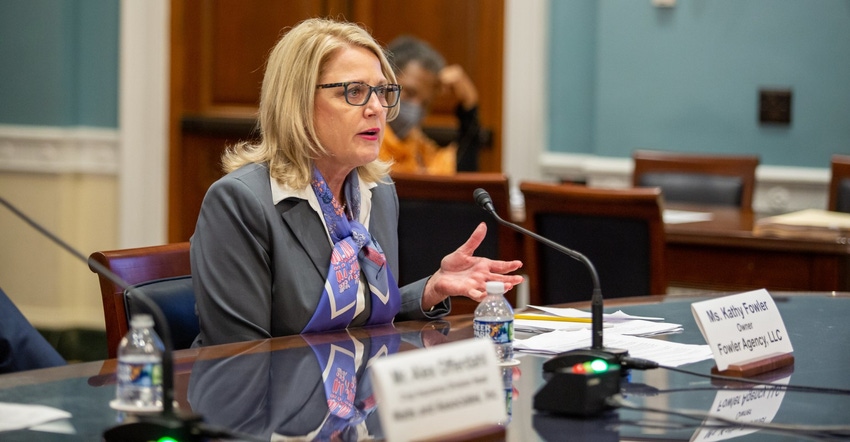
Throughout the last two farm bill reauthorization processes, the message Rep. Cheri Bustos, D-Ill., heard loud and clear was: “Do no harm to crop insurance,” and that message continued to be conveyed during a House Agriculture Subcommittee on General Farm Commodities and Risk Management farm bill oversight hearing on crop insurance on July 29.
“The program has been and continues to be a central risk management tool for producers across the country, and it has continued to grow and evolve to address the challenges and risks our producers are facing,” Bustos says.
Kathy Fowler, a crop insurance agent from Texas on behalf of the Crop Insurance Professionals Association, testified that since 2000 the farmer paid crop insurance premium has increased six-fold and now insures 130 crops. The acres insured has risen from 200 million acres to 450 million acres. This growth has allowed the average loss ratio to remain well under the statutory requirement of 1.0, Fowler says.
Bob Haney, executive chairman of Approved Insurance Provider AgriSompo North America, testified on the importance of continued support for the current “3-legged stool” crop insurance model, as well as continued flexibility for farmers to ensure coverage allows them to make the best decisions for their business and the environment alike.
Crop insurance, in its current form, is designed through a model in which AIPs and the federal government share in the risk of the policies. Farmers pay a premium and must meet a deductible before receiving a payment. Thereby, all three parties have a financial stake in ensuring the success and integrity of the program.
Minnesota farmer and National Corn Growers Association First Vice President Tom Haag testified that the number one priority for the farm bill for corn growers is to protect crop insurance from the harmful budget cuts and reforms. “Our nationwide survey shows that corn growers overwhelmingly chose the crop insurance title as the most important, and that cuts to federal crop insurance would negatively impact our farming operations,” he says.
Fowler did offer some dos and don’ts for legislators as they consider changes to crop insurance in the next farm bill.
“Don't be tricked into pay limits and [adjusted gross income] means testing on crop insurance under the idea that this will help small farmers because it won't. It will hurt them by raising your premiums and removing the good risks from the risk pool,” she says.
She also warned that cutting premium cost shares and increasing premiums would move the program backwards.
Ahead of the hearing, the National Sustainable Agriculture Coalition published a special report which evaluates five payment limit scenarios of crop insurance payment limits. Versions of nearly all five of the scenarios have been previously introduced in Congress as part of bills or as amendments to bills. The report concludes that the savings in federal expenditures could be reallocated to other high priority programs.
The report finds that the strictest cap that is evaluated requires the complete elimination of insurance subsidies for any farm with an AGI over $250,000, which would amount to total savings of $20.2 billion and would impact 10.66% of all farms. All of the other caps would provide some amount of savings on subsidy payments and reduce the extent to which subsidy payments are concentrated on a few farms, but to a lesser extent. “Such savings in federal expenditures could be reallocated to other higher priority programs (e.g., agricultural research, conservation, beginning farmer and rancher programs, etc.), reduce tax burdens on taxpayers, or reduce the federal budget deficit,” the report notes.
Permanent disaster
Subcommittee ranking member Rep. Austin Scott, R-Ga., says since 2017, Congress has provided additional assistance to producers in the form of ad hoc disaster aid, but crop insurance remains a stable safety net compared to disaster assistance.
“The inefficiencies in delivery, the delay in funding and payments, and the uncertainty of if or when Congress may act underscores the benefits and importance of having a well-functioning insurance program,” Scott says. “Crop insurance delivers timely assistance in the wake of a disaster and provides some level of protection to farmers and their lenders.”
Recent discussion by many members of Congress have indicated a desire to see a permanent disaster program established. Haney says he would discourage the creation of a disaster program that would disincentivize farmers from purchasing crop insurance or that would directly compete with existing crop insurance products or products that are currently available in the private sector. “We actually don’t want to see the creation of a program that would double pay farmers,” he says, which could indirectly discourage the purchase of crop insurance and possibly lead to changes in farming practices that could lead to potential instances of fraud, waste and abuse.
Fowler always warned against permanent disaster programs that undermine the crop insurance program. “You don’t want to discourage producers from using their own risk tools.”
Climate focus
Haney says as Congress begins to evaluate the intersection between agriculture and climate change, it’s important to note that farmers’ first line of defense against climate change is crop insurance. There have been studies that show farmers who purchase crop insurance are more likely to undertake climate smart agricultural practices than those who do not purchase crop insurance, he says.
“Don’t try to mix policy objectives like climate into crop insurance,” Fowler says. “Crop insurance is meant to protect the farmers profitability. When profitable, good conservation will follow.”
Any intersection between climate smart ag practice adoptions and crop insurance should maintain the actuarial soundness of the crop insurance program, Haney says. “Second, intersections between climate and crop insurance should be incentivized to not place additional mandates on farms or records,” he continues.
Hany adds new climate initiatives should be funded on their own terms, and not take money away from the current crop insurance title of the farm bill.
About the Author(s)
You May Also Like






